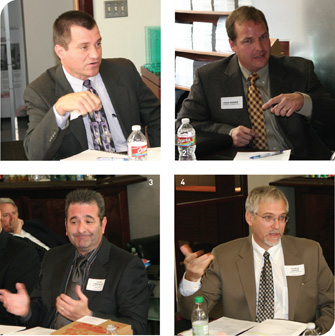
1. China and India are turning out a huge number of engineers, but the populations in those countries justify that trend, said Kevin Honomichl. | 2. The 24-hour work clock, brought to us by collaborations with overseas partners, presents special challenges, Drew Rimmer noted. | 3. Cliff Greenlief said globalization within the sector would remain a long-term challenge. | 4. Charlie LePage noted a gap between university-level instruction and practical applications.
International
As Steve Hofmeister noted, China and India are producing engineers at a high rate and opening new engineering schools as well.
“Those economies are growing so much faster. They’re adding population so much faster than the United States and it’s almost a bit out of necessity,” affirmed Kevin Honomichl, president of BHC Rhodes.
Thornton Tomasetti and a number
of other firms have taken advantage of this economic surge by opening up in-ternational offices. Hofmeister asked what challenges his colleagues faced from the internationalization of their practices.
Drew Rimmer offered a few cautions. The 24-hour clock presents a challenge, and his Indian colleagues have a different work ethic as well as a distinctive way
of managing projects and employees. “You have to really understand their culture in order to communicate with them,” he said. “So that’s been pretty difficult.”
Jim Lewis added a few more cautions. The number one challenge, as he sees it, is employee retention. Given the opportunities available to ambitious engineers, Black & Veatch has had trouble with retention in India, China, and Thailand.
As a result of language and cultural differences, firms have to be much clearer when they hand off work. Productivity has been a challenge too. “Here,” said Lewis, “we have a lot of leadership that can guide people.” That is less true overseas.
As to an ingenuity differential, Lewis gives the nod to Midwestern engineers. “I think there’s a more practical constructability thing when you hire a farm boy that went to K-State,” said Lewis, “than you get from someone who grew up in an apartment building on the 17th floor.”
“I think our industry owes it to itself to be aware of what’s going on in China and India,” said Cliff Greenlief. “That whole flattening of the planet, it is something we will have to deal with one way or the other.”
Joe Marsh agreed. “We have the bene-fit of a strong work ethic,” he said, then added, “but we’re probably not as strong on the multicultural side.”
Mike Fenske sees the need to diversify the kind of education engineers receive, here or abroad. Today, engineers have to know how to apply their skills to complex situations and how to uti-lize the talent around them to organize projects.
“I think, from a global economy standpoint,” Fenske said, “perhaps some of the best opportunity we have is our ability to continue to gather those talented people that want to learn how to apply those sophisticated tools.”
Education
One subject of ongoing interest was the state of engineer formation, particularly through higher education. Steve Hofmeister asked his colleagues what they needed from universities and whether they and their new recruits were getting it.
Charlie LePage believes that the university programs “seem to lag behind in technology.” He has discovered many young engineers to be well-trained in the theoretical aspects of engineering, but not well enough exposed to practical application for real-world projects.
“Is that an area where we as a profession should be stepping in and providing more guidance?” Hofmeister asked. He speculated that most firms have at least one representative at all the universities, either teaching or consulting. “Is that enough?” he wondered. “Should we be doing more as a profession?”